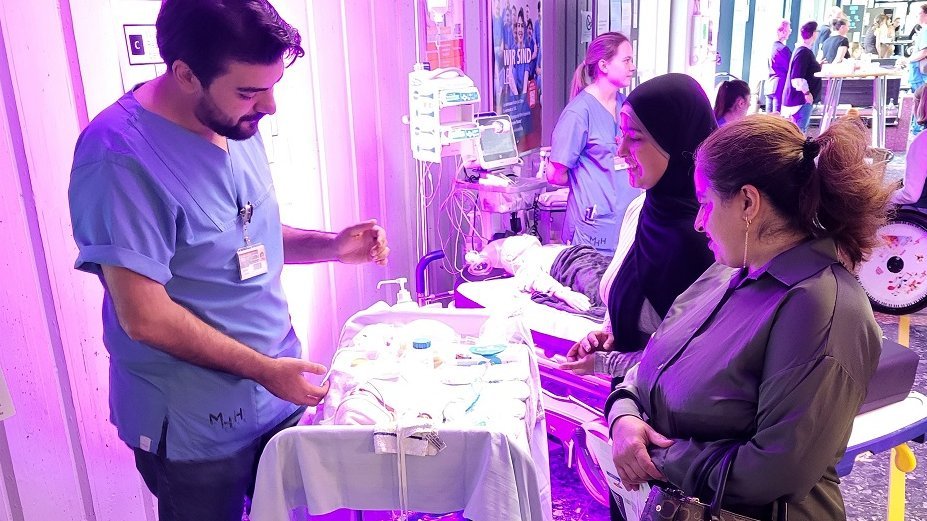During the 2025 campus tour, MHH presented its diverse range of educational and career opportunities.

MHH Nursing presented itself to visitors at several stands. Copyright: Tina Götting/MHH
About to graduate from school, but no idea what career to pursue? Students found inspiration at this year's MHH campus tour. The university is one of the largest employers in the Hanover region and offers numerous training opportunities – not only in the health sector. Hundreds of visitors attended the event on 6 September and went on a journey of discovery into their professional future with friends or parents in the J2 lecture hall building.
21 apprenticeship professions
Every year, around 600 young women and men start their professional lives at MHH. The university offers a total of 21 apprenticeship professions, from A for anaesthesia technician to Z for dental assistant. In between, there are numerous others, such as biology laboratory assistant, media and information services specialist, dietitian, electronics technician for automation technology, warehouse specialist, healthcare administrator, speech therapist and IT specialist. Since the MHH is not only a large hospital but also a research centre with a large administration and technical department, the career opportunities are correspondingly diverse. There was a lot to see and learn on the campus tour – at information stands, in workshops, on guided tours, at lectures and during career speed dating.
Practical overview
While some visitors headed straight for specific information stands, others came out of general interest. Like Jacob (26). ‘I already have a job,’ said the aerospace engineer. Nevertheless, he found the Central Research Workshops stand interesting. There, trainee Janio Medina showed him how ‘pneumatic separation’ works. This is a mechanism that works with compressed air, and the trainees have to manufacture its components themselves according to technical drawings to become industrial mechanics. Fifteen-year-old Luisa came to the campus tour to ‘just get an overview of the training opportunities.’ At the animal laboratory's information stand, she talked to training manager Christa Ziegowski and apprentice Hannah Twiefel, who showed her what mice and rats need in their cages to feel comfortable. ‘Animal welfare is a top priority for us and also plays an important role in training,’ emphasised Christa Ziegowski.
Guided tours of real workplaces
Anyone who wanted to know what the real working environment of certain professionals looks like could take part in one of the numerous guided tours. One of these was offered by medical technologists for radiology Daria Ilina and Inka Haas. They not only explained to their group of visitors how X-ray machines and CT and MRI scanners work, but also showed spectacular images from examinations – for example, of a gunshot wound to the hip and a swallowed key. There were also tours of the library, the school for medical laboratory technicians, the dermatology clinic, the paediatric clinic, human resources, the school for dieticians and the operating theatre, where surgical and anaesthesia assistants showed visitors their workplace.
Diversity in nursing
The nursing professions presented themselves in their entire spectrum with different areas of focus. Simon Müller and Sabrina Westphal, both anaesthesia and intensive care specialists, gave a workshop to convey impressions of the work in an intensive care unit. The motto was ‘get involved’. Participants Nele (15) and Lara (16) were allowed to practise resuscitation and monitor vital signs on a life-size model. ‘I would like to work in the surgical field later on and find out more about it today,’ explained Nele. She clearly enjoyed the practical exercise. Nastaram (15) is interested in another area of nursing. The student visited the information stand of the children's clinic and had many questions for Hikmet Cetinkilic, deputy head of wards 63, 65 and the children's emergency room. The expert explained to Nastram how triage is used to determine the urgency of a patient's treatment and how newborns are correctly lifted out of their beds and put back down again.
Degree programmes and voluntary services
Several degree programmes were also represented at the campus tour. School pupils interested in business administration, business economics or midwifery (bachelor's degree), for example, were able to find out more at information stands. And those who wanted to do federal voluntary service, a voluntary social year or a voluntary year in science before starting their training or studies also found the right people to talk to. Also represented on the campus tour were the Patient University, Occupational Health Management and the Erasmus+ programme.
Text: Tina Götting



![[Translate to Englisch:] Eine Schülerin sitzt an einem Tisch des Standes der MTL-Schule und blickt in ein Mikroskop.](/fileadmin/_processed_/f/c/csm_Campustour_2025_18_7720f1cf9f.jpg)
![[Translate to Englisch:] Zwei Besucher:innen informieren sich an einem der Pflege-Stände.](/fileadmin/_processed_/d/c/csm_Campustour_2025_28_1b273d617d.jpg)